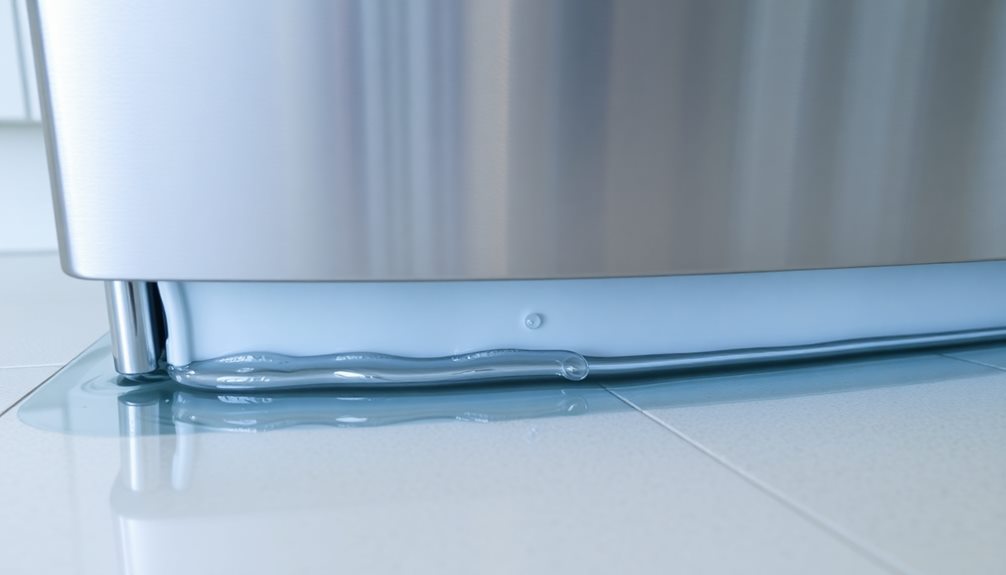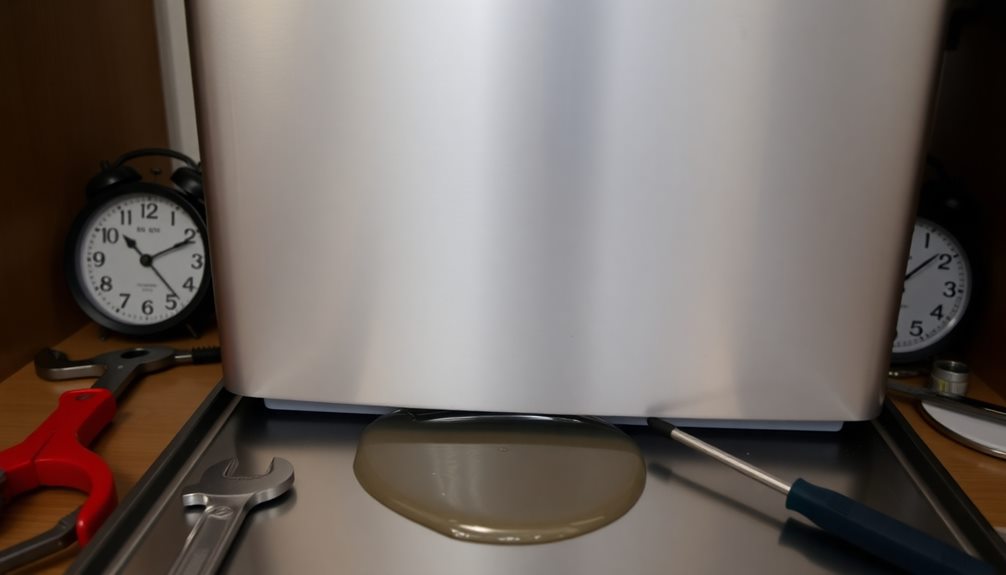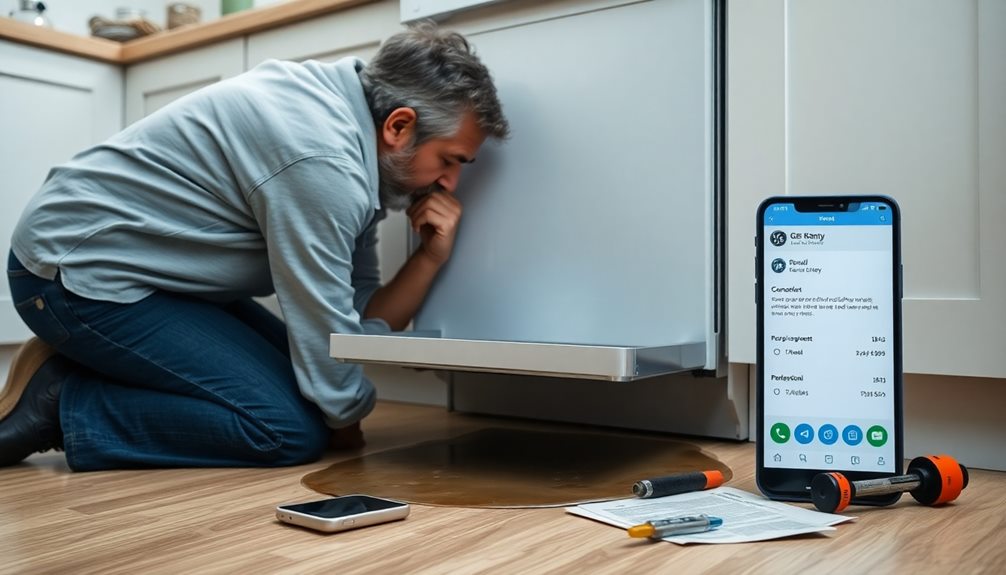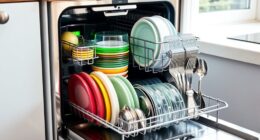If your GE dishwasher is leaking from the bottom of the door, you should act quickly. First, check the door gasket for damage and verify the door closes properly. Inspect spray arms and water hoses for blockages or loose connections. Using too much detergent can also create excess suds, so adjust accordingly. Keep an eye out for water pooling or damp areas around the appliance, as these are signs of a leak. Addressing these issues promptly can prevent further damage and mold growth. Want to uncover more effective solutions? Keep exploring the steps you can take!
Key Takeaways
- Inspect the door gasket for damage or wear, as it may need replacement to prevent leaks.
- Ensure proper loading of dishes to avoid obstructing spray arms, which can cause splashing.
- Check hose connections for looseness; tighten any loose connections to stop leaks.
- Clean the air gap to remove blockages that can back up water and lead to leaks.
- Schedule professional maintenance for expert diagnosis and timely repairs to prevent further issues.
Common Causes of Leaks
Identifying the common causes of leaks is essential for keeping your GE dishwasher in top shape. One frequent issue is a damaged dishwasher door gasket. If you notice a water leak, inspect the gasket for tears or cracks, as this damage can allow water to escape during cycles.
Another culprit could be excessive detergent usage, which creates suds that overflow, often resulting in leaks at the door.
If your GE dishwasher model has loose hose connections or clamps, you might find water leaking from the bottom of the unit. Regularly inspect and clean these connections to guarantee they're tight and secure.
Additionally, clogged air gaps can back up water and lead to leaks, so make it a habit to check and clean them whenever you run your dishwasher.
Lastly, improper loading of dishes can obstruct the spray arms, causing water to splash out and create leaks around the door. By paying attention to these common causes, you can prevent leaks and maintain your dishwasher's efficiency.
Steps to Troubleshoot

When leaks occur in your GE dishwasher, taking immediate action can prevent further damage and maintain efficiency.
Start by inspecting the door gasket for any signs of wear or damage. A faulty seal is a common source of leaks at the bottom of the door.
Next, check the dishwasher door for proper alignment; it should close securely, and the hinges must operate correctly. Misalignment can lead to water escaping during the wash cycle.
Afterward, examine the spray arms for blockages or damage. If they're obstructed, water is leaking from the door due to splashing during operation.
Don't forget to verify that all hose connections are tight and free of leaks. Loose or damaged hoses can contribute to water accumulation at the base of the dishwasher.
Signs of Leakage

If you notice water pooling below your dishwasher door, it's a clear sign something's not right.
A damp floor surrounding the unit can indicate a leak that needs immediate attention.
Keep an eye out for visible water drips, as these can point to potential issues that could escalate if ignored.
Water Pooling Below Door
Water pooling below the door of your GE dishwasher often signals a leak that needs immediate attention. This issue can arise from a damaged door gasket or misaligned seals.
If you notice water pooling below the door, it's vital to check the door for any signs of wear and tear. A faulty door gasket is a common culprit for leaks, allowing water to escape during cycles.
Additionally, excessive suds from overusing detergent can cause water to overflow, leading to noticeable pooling. Be certain to inspect the corners of the door for any moisture accumulation, as this is a typical area where leaks manifest.
If you see water during operation, especially when the lower spray arm is rotating, it might indicate a blockage or malfunction in the pump system.
Regularly inspect the door latch and hinges, too. Misalignment can prevent a proper seal, resulting in water leaking from the bottom of the door.
Damp Floor Surrounding Unit
A damp floor surrounding your dishwasher unit signals a potential leak that shouldn't be ignored. This moisture may be caused by a faulty door gasket, misalignment, or even excess detergent leading to suds overflow. If you notice puddles forming near the base, it's crucial to address the issue before it escalates.
| Signs of Leakage | Implications |
|---|---|
| Damp floor | Potential leak |
| Water stains on cabinetry | Ongoing leaks |
| Consistent moisture | Risk of mold growth |
| Faulty door gasket | Misalignment issues |
Ignoring a damp floor can lead to serious consequences, including mold growth that poses health risks. Additionally, water stains on cabinets indicate that leaks have been ongoing, requiring immediate investigation. Regularly inspecting hose connections and seals can help you catch early signs of leakage, preventing further moisture issues around your appliance. Don't let a small problem turn into a big mess; stay proactive in maintaining your dishwasher to keep your kitchen dry and safe.
Visible Water Drips
Noticing visible water drips from the bottom of your dishwasher door can point to significant issues that need your attention.
These water drips often indicate a problem with the door gasket, which might be worn out or not properly seated. If the gasket isn't sealing correctly, water can escape during the wash cycle, leading to leaks.
Additionally, if you see water pooling in the bottom corners of the door, it could suggest misalignment or faulty hinges that prevent a tight seal when closed. This misalignment can exacerbate leaking issues, so it's crucial to check for proper door alignment.
Another factor to take into account is the lower spray arm. If it's clogged with debris, it may not rotate freely, causing water to splash out instead of circulating within the dishwasher.
Regularly inspect for visible water stains on your cabinetry, as they can indicate ongoing leaks and signal a need for immediate repairs.
Importance of Timely Repairs

When you spot a leak in your GE dishwasher, it's crucial to act quickly. Timely repairs can prevent costly damage not only to your appliance but also to your flooring and cabinetry, which can lead to thousands of dollars in repairs.
A leak from the bottom can cause water to pool, creating the ideal environment for mold and mildew to thrive, posing health hazards in your home. Additionally, maintaining your kitchen appliances, like ensuring the air quality with air purifiers for improved health, can further enhance the overall safety of your living space.
By addressing leaks promptly, you enhance efficiency and performance, ensuring your dishwasher operates at peak capacity while conserving water. This not only saves you money on utility bills but also contributes to environmental sustainability by minimizing water waste.
Proactively managing your dishwasher's issues helps extend its lifespan, delaying the need for expensive replacements and keeping your kitchen running smoothly.
Seeking Professional Assistance

Dealing with a leaking GE dishwasher can be frustrating, and sometimes, DIY fixes just won't cut it. If you've tried troubleshooting and the leak persists, it's time to think about seeking professional assistance. A certified technician from GE Appliances can provide expert diagnosis and repair, guaranteeing your appliance gets the attention it needs.
One of the advantages of hiring a professional is that they carry an extensive inventory of parts, allowing them to complete most repairs on the first visit. This not only saves you time but also spares you the hassle of multiple appointments.
In addition, if your dishwasher leak has caused significant water damage or poses electrical hazards, immediate professional assistance is vital for your safety.
GE Appliances also offers warranty coverage on repairs performed by certified technicians, giving you peace of mind for your appliance maintenance. Regular maintenance by a professional can help identify potential issues early and prevent leaks from occurring in the future.
Don't hesitate to reach out to a certified technician; it's often the best way to make sure your dishwasher operates smoothly and efficiently.
Maintenance Tips for Longevity

To keep your GE dishwasher running smoothly, regularly check the door seals for any signs of wear.
Proper loading techniques also play an essential role in preventing leaks, so make sure dishes aren't blocking the door from sealing tightly.
Regular Seal Inspections
Regular seal inspections are essential for keeping your GE dishwasher running smoothly and preventing leaks. Start by examining the door gasket regularly for any signs of wear, such as tears or hardening. A compromised seal can lead to leaks during the wash cycle, causing damage to your kitchen.
Make it a habit to clean the door seals monthly. Food particles and detergent residue can build up over time, degrading the gasket material and reducing its effectiveness.
Also, check the alignment of the dishwasher door each time you use it. A properly aligned door guarantees a tight seal and minimizes the risk of leaks.
If you notice any damage or misalignment in the gasket, replace it promptly. Ignoring a worn seal can lead to water escaping during operation.
Additionally, schedule annual professional maintenance inspections to ascertain all components, including seals and hoses, are functioning correctly. Catching potential issues early can save you from unexpected leaks and costly repairs down the line.
Proper Loading Techniques
Maintaining the integrity of your GE dishwasher goes beyond regular seal inspections; proper loading techniques play an essential role in preventing leaks and guaranteeing peak performance.
By loading your dishes thoughtfully, you can avoid issues like water pooling and leaks from the bottom door.
Here are three key tips to follow:
- Clear the Spray Arms: Load dishes in a way that keeps them clear of the spray arms. Confirm they've enough clearance to rotate freely during the wash cycle.
- Position Larger Items Correctly: Place larger pots and pans on the bottom rack, avoiding contact with the dishwasher walls or door. This prevents pressure points that can cause the dishwasher door gasket to fail, leading to leaks.
- Angle Smaller Items: On the top rack, position smaller items and cups angled downwards. This allows water to drain properly, minimizing the chance for water to leak out of the door.
Frequently Asked Questions
Why Is My GE Dishwasher Leaking at the Bottom of the Door?
If your GE dishwasher's leaking at the bottom of the door, check the door gasket for damage, verify you're using the right detergent, and inspect for clogs or loose hoses causing the issue.
Why Is My Dishwasher Leaking From the Bottom Corner of the Door?
If your dishwasher's leaking from the bottom corner of the door, check the door gasket for damage, guarantee proper alignment, avoid excess detergent, and inspect the spray arms for blockages. Tighten any loose hinges too.
How Do I Stop My Dishwasher Leaking From the Bottom?
Your dishwasher's like a boat with a hole; to stop the leaks, check the door gasket, make certain it's level, clear spray arms, tighten the latch, and clean the drain filter regularly.
How Do You Replace the Seal on the Bottom of a Dishwasher Door?
To replace the seal on your dishwasher door, disconnect power and water first. Remove the outer panel, pull out the old seal, insert the new one, and reattach the panel securely to prevent leaks.
Conclusion
In summary, addressing a leaking dishwasher promptly is essential to prevent further damage and costly repairs. Did you know that about 75% of dishwasher leaks stem from door seals and gaskets? By regularly checking these components and following proper maintenance tips, you can extend your appliance's lifespan considerably. If you're ever unsure about a repair, don't hesitate to seek professional help. Keeping your dishwasher in top shape guarantees it serves you efficiently for years to come.









